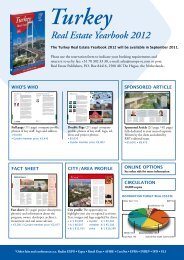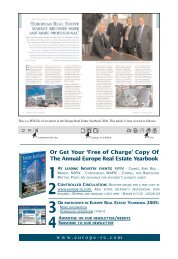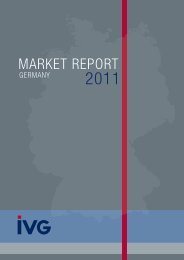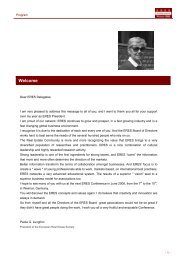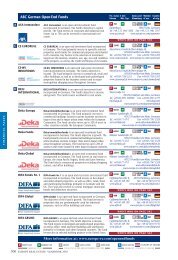DIRECT MARKET REPORT GERMAN RETAIL - Europe Real Estate
DIRECT MARKET REPORT GERMAN RETAIL - Europe Real Estate
DIRECT MARKET REPORT GERMAN RETAIL - Europe Real Estate
Create successful ePaper yourself
Turn your PDF publications into a flip-book with our unique Google optimized e-Paper software.
(30%) 4 . The preference for hypermarkets and superstores in the state of North<br />
Rhine-Westphalia (50 percent) is not surprising given the densely populated<br />
conurbations in that state. Both retailers and investors will in future place more<br />
weight on sites within the German inner cities and residential centres. This hardly<br />
comes as a surprise given the forecast of demographic change in Germany. The<br />
agglomeration formats are not only limited to shopping centres, but the<br />
expectation is also for retail parks and/or retail warehouse centres to grow.<br />
Supply<br />
4 Hahn Group survey 2007/2008<br />
As stated before, the amount of square meters (GLA) per 1,000 inhabitants has<br />
always been below the <strong>Europe</strong>an average, i.e. tends to be in short supply in<br />
Germany. Today Germany has 360 shopping centres for more than 11 million<br />
square meters, which means that shopping centre space has nearly doubled over<br />
the past 10 years. In 2006 another 20 centres got up and running and currently<br />
another 27 malls are in the pipeline (1,150,000m 2 ). But this still means only<br />
145m² of shopping centre space for every 1,000 inhabitants, which is lower than<br />
the EU-24 average of 176m²/1,000 (EU-15 219m²/1,000). This is quite a contrast<br />
with Spain (200 m²), even Portugal, France and both number one and two, the<br />
Netherlands and Sweden (> 400m²) per 1,000 residents. Especially retail<br />
warehouse formats are less widespread than in other countries as municipalities<br />
are trying to protect their downtown locations.<br />
Tight planning in more mature markets such as the UK, France and Germany has<br />
shifted the focus back to in-town development. Only 4% of all shopping centres in<br />
Germany built since 2002 are on green fields. In Germany one can definitely<br />
speak about a so called “back to the city centre” trend; in the years 1995-1999<br />
the share of inner-city shopping centres was only 30.5%, which rose to almost<br />
50% in the last 5 years. Presently large scale schemes which are increasingly<br />
located on central and peripherical inner-city sites for its high frequency of visitors<br />
are regarded as attractive. Especially the ones that contain a full multifunctional<br />
range are unbeatable; shopping, office, residential, public services, culture,<br />
gastronomy and leisure facilities. Besides a less restrictive interpretation of<br />
building laws and permits in inner cities, a central factor for this trend could well<br />
be the more favourable risk assessment of real estate in city locations compared<br />
to other locations.<br />
On the other hand, the old high streets will always attract people in order to shop<br />
in the more old fashion way, especially in summer time. Therefore it’s crucial to<br />
rededicate or re-position obsolete properties in between the chique warehouses<br />
and shopping centres.<br />
German retail update - 28/11/2007 21




